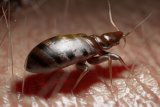Take the Bite Out of Bed Bugs
As an EPA pest management specialist, I spend my days helping citizens control pests without harming their environment or families. I receive calls from everywhere — from northeastern inner cities to Alaskan rural tribes — to assist people with bed bug infestations. Many who reach out have exhausted every resource— landlords, over-the-counter products, or online solutions. EPA’s Center for IPM and affiliated regional offices specialize in providing effective tips and best practices for evicting bed bugs.
I got my start at EPA in the pesticides program of our Region 2 office, which covers New York, New Jersey, and the Caribbean. I spent many years developing pest management strategies for daycares and schools. Now I educate the public through EPA’s Integrated Pest Management (IPM) webinar series.

How can you identify a bed bug? Adult bed bugs are reddish-brown and about the size of an apple seed. They are wingless and do not jump. Instead, they use their legs to dash across surfaces. Bed bugs are also nocturnal. They gather in cracks and crevices during the day. Then at night, they travel from their hiding places to feed and then scurry back before daylight.
Bed bugs are attracted to exhaled carbon dioxide and love warm bodies that are stationary for long periods of time – exactly like you when you’re sleeping! The good news is, they do not transmit diseases to humans. However, their bites can cause itchiness, inflammation, skin infections, stress, anxiety and sleeplessness.
These stubborn pests are infamously hard to get rid of, but busting bed bugs is my specialty.
What Works for Bed Bug Control
Purchase protective covers that seal mattresses and box springs.
With covers that seal, the bed bugs will get trapped inside and die. In addition, keep your bed a few inches from walls and ensure that your bedding is not touching the floor. Then, place bed bug traps under the legs of beds and any other plush furniture in your home.
Seal any small hiding areas.
Use silicon caulk to seal cracks and crevices where these pesky critters might hide. This eliminates hiding places and gets the bugs out in the open. Pay extra attention to walls shared with other homes.
Vacuuming is effective in combination with other methods.
Vacuuming not only removes the bugs, but also cleans up bed bug skins. Immediately seal and dispose of the vacuum bag outdoors — otherwise the bed bugs will crawl out again. For bagless vacuums, empty the contents outside into a bag and then into an outdoor garbage bin.
Use clear plastic storage containers to store important belongings.
The smooth interior of the container makes it difficult for trapped bed bugs to climb out, so wandering bed bugs are likely to fall to the bottom and stay there.
Use bed bug interceptor traps to detect and control, especially in residences with a history of bed bugs.
These traps are commercially available or can be made using materials commonly found around most homes.
Pesticides can help if used properly.
Remember that pesticides are just one tool and rarely control bed bugs alone. Only purchase EPA-registered pesticides, which have an EPA registration number on the label, and only buy those whose label says they control bed bugs. It is critical to use the pesticide according to the label directions. Do not over-apply — more is never better!
What Won’t Work
- Rubbing alcohol, kerosene and gasoline: They could harm you and your family and can easily ignite with a spark or cigarette.
- Many natural oils and home remedies have not been proven effective.
- Many home refrigerator and freezers are not cold enough to kill bed bugs. For effective treatment, infested items need to be in a sealed bag in a freezer set to zero degrees Fahrenheit for three days.
- Do not try to kill bugs by increasing your indoor temperature with a thermostat, propane space heater, or fireplace – this does not work and can be dangerous.
- Sticky traps are not for bed bugs, but they may be effective at catching spiders, cockroaches, and other insects.
For more information about how to identify and manage bed bugs, visit EPA’s bed bug website and check out resources from the National Pesticide Information Center.
A bed bug infestation can feel like the end of the world, but you have options. In my job, I work every day supporting EPA’s mission of protecting human health and the environment. That mission supports more than the environment you find on mountain peaks, or on ocean floors, it also means promoting responsible environmental practices around your neighborhood and home.
So don’t bug out about bed bugs – we’re here to help!

About the Author
Marcia Anderson, PhD
Environmental Protection Specialist
Office of Chemical Safety and Pollution Prevention
Marcia Anderson is an Environmental Protection Specialist within EPA’s Office of Pesticide Programs. She holds a Ph.D. in Environmental Management from Montclair State University. Prior to civil service, she was a professor of Earth and Environmental Studies, Geology, and Oceanography for 15 years. Marcia is an avid EPA writer, blogger, and webinar producer who loves spending her free time with family in New Jersey and Maine.
Editor’s Note: The views expressed here are intended to explain EPA policy. They do not change anyone’s rights or obligations. You may share this article. However, please do not change the title or the content, or remove EPA’s identity as the author. If you do make substantive changes, please do not attribute the edited title or content to EPA or the author.
EPA’s official web site is www.epa.gov. Some links on this page may redirect users from the EPA website to specific content on a non-EPA, third-party site. In doing so, EPA is directing you only to the specific content referenced at the time of publication, not to any other content that may appear on the same webpage or elsewhere on the third-party site, or be added at a later date.
EPA is providing this link for informational purposes only. EPA cannot attest to the accuracy of non-EPA information provided by any third-party sites or any other linked site. EPA does not endorse any non-government websites, companies, internet applications or any policies or information expressed therein.
